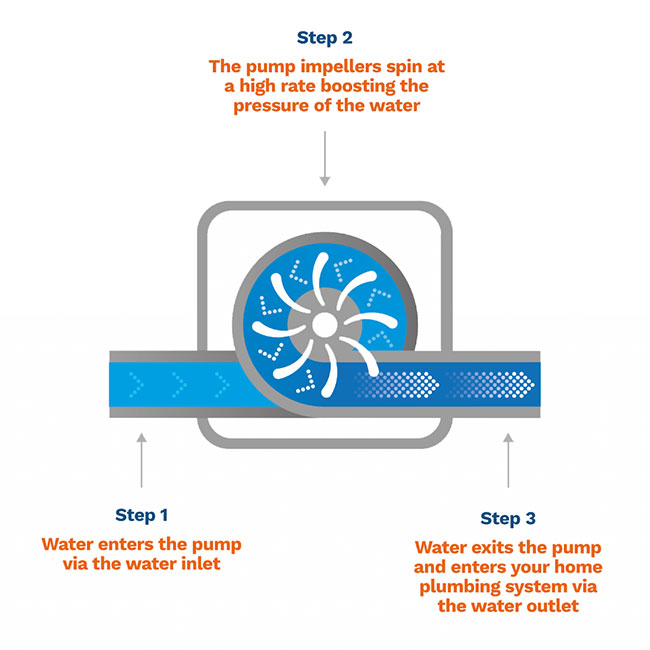What is a Booster Pump?
A booster pump is a device used to increase the pressure of fluids and is widely applied in industrial production, agricultural irrigation, urban water supply, and other fields. In this article, ATO industrial automation will provide a detailed overview of the structure, working principles, advantages, and applications of booster pumps.
Structure of Booster Pump
- Drive Unit: Typically powered by devices such as electric motors or pneumatic motors to drive the pump body during operation.
- Pump Body: Usually composed of components such as the pump head, pump chamber, and diaphragm. The pump head serves as the inlet and outlet, while the pump chamber, often made of compressible diaphragms, facilitates the suction and discharge of liquids. The pump body is typically manufactured from metal or non-metal materials to ensure stability and reliability.
- Diaphragm: A critical internal component that divides the pump chamber into two sections. As the pump operates, the diaphragm vibrates periodically, facilitating the suction and discharge of liquids.
- Outlet Valve: When the liquid flow reaches a certain value, the outlet valve automatically opens to allow the liquid to flow out.
Working Principles of Booster Pump
The working principles of a booster pump are based on fluid mechanics and mechanical principles, converting mechanical energy into fluid pressure. The following outlines the detailed working process of a booster pump:
- Suction Process:
The working cycle begins with the suction process. When the pump starts, the impeller begins to rotate, creating a low-pressure zone. Depending on the pump's design, the pressure at the suction port is lower than the atmospheric pressure, allowing the liquid to be drawn into the pump. - Compression Process:
Once the liquid is drawn into the pump, the impeller's rotation pushes the liquid toward the pump's outlet. During this process, the liquid is compressed, increasing its pressure. Booster pumps typically use centrifugal or reciprocating (plunger) pump designs, each with slightly different working principles.
- Centrifugal Pump: The impeller's rotation generates centrifugal force, imparting centrifugal acceleration to the liquid, increasing its kinetic energy. As the liquid approaches the pump outlet, kinetic energy is converted into pressure energy, raising the liquid's pressure.
- Reciprocating Pump: The plunger's up-and-down movement changes the pump chamber's volume, compressing the liquid. As the plunger moves downward, the pump chamber's volume decreases, forcing the liquid out. When the plunger moves upward, the pump chamber's volume increases, creating a vacuum that draws liquid into the pump.
- Discharge Process:
The compressed liquid is discharged from the pump's outlet, flowing into the required system or equipment. During the discharge process, the pressure energy of the liquid is transferred to the system for its use.
Advantages of Booster Pump
- Powerful Boosting Capability: Booster pumps can pressurize low-pressure liquids or gases to the required high-pressure levels, making them a valuable energy supply for industrial production.
- Easy Operation: Booster pumps are straightforward to use; simply connect the inlet and outlet pipes correctly and press the start button.
- Energy Efficiency and Environmental Friendliness: By controlling the pump's operating speed during the pressurization process, energy efficiency can be achieved, simultaneously reducing pollution emissions associated with energy consumption.
Applications of Booster Pump
- Industrial Production:
In industrial production, booster systems are commonly used to convey liquids or gases, providing the required pressure. For instance, in pipeline systems for transporting crude oil, petroleum products, and chemical liquids, booster pumps are employed to ensure sufficient pressure for smooth flow.
- Agricultural Irrigation:
In agricultural irrigation systems, booster pumps are used to provide the necessary pressure for transporting water from water sources to fields. Through booster pumps, water can be evenly distributed to fields through irrigation system pipes and nozzles, meeting the growth requirements of crops. - Urban Water Supply:
In urban water supply systems, booster pumps are used to provide sufficient pressure for transporting water from water sources to residential or commercial buildings. Booster pumps help overcome pipeline resistance, ensuring water reaches every faucet in users' homes.
In summary, a booster pump is a device used to increase fluid pressure, working on the principles of fluid mechanics and mechanical engineering. Through the processes of suction, compression, and discharge, booster pumps convert the kinetic energy of liquids into pressure energy, providing the required fluid pressure. Booster pumps find widespread applications in industrial production, agricultural irrigation, and urban water supply.

